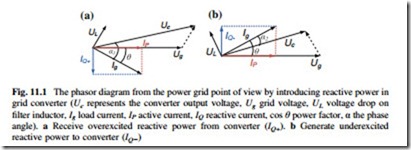The growing requirements for reliability and grid integration push the solutions of wind power generation system from doubly fed induction generator (DFIG) with partial-rated power converter to synchronous or asynchronous generator with full-scale power converter. In the full-scale power converter solutions, there are more flexibilities to control the reactive power, and it is easier to satisfy the grid voltage support requirements by most of the grid standards under both normal and faults condition of the power grid.
However, the added reactive power, especially in the application of multi-MW wind power conversion, may increase the converter output voltage (modulation index) and change the amplitude as well as phase angle of the load current in the grid side inverter, as shown in Fig. 11.1. The voltage and current phasor diagram from the point view of power grid by introducing the overexcited and underexcited reactive current IQ in grid connected converter are indicated respectively. Referring to the commonly used and accepted loss model, the modified output voltage and load current will change the loss consumption and distribution, and thereby lead to the change of thermal cycling (or junction temperature) of power switching devices. According to most of the reliability models for power semiconductor, the lifetime of the wind power inverter is closely related to the thermal cycling performance––both average mean junction temperature and temperature fluctuation amplitude, therefore it is interesting to investigate the relationship between the reactive power and the resulting modified thermal cycling for multi-MW wind power inverters.
In this special topic, the allowable reactive power ranges as well as their impacts on thermal cycling of wind power inverters are presented at different wind speeds. The situations when considering single converter and paralleled converter systems in a wind park are analyzed respectively. A new concept is also proposed to stabilize the device thermal fluctuation during wind gust by controlling the reactive power circulated among parallel converter systems in a wind park.
